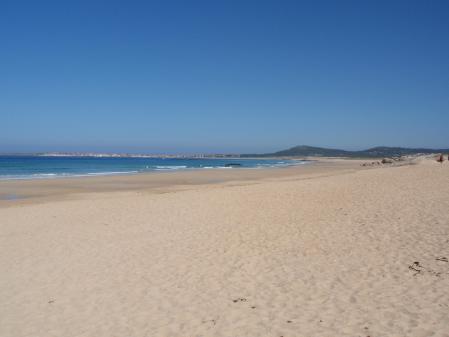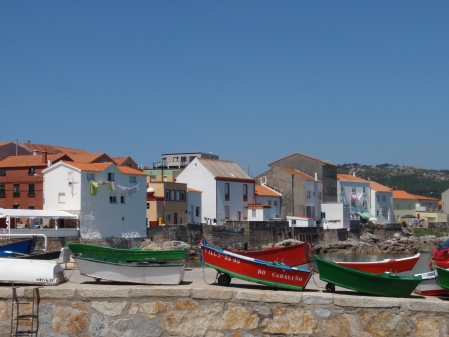
Galicia is a popular holiday choice with Spanish people living in the south because they like to holiday in the north to escape the oppressive heat and enjoy Galicia’s famous seafood. In August alone, eight million Spaniards travel north from cities like Madrid and Toledo to the more temperate climate of Galicia with its green scenery and spectacular beaches.
The climate though is changeable and the region is often referred to in Spain as the wet or rainy region. The local geography is also dramatically different from that of the central and southern regions with meadows, hills and mountains and is known affectionately in Iberia as green Spain.
In 1998 I won a competition in the Times newspaper for an all expenses paid weekend to a chateaux in Cahors in France. This was the result of answering three simple questions about the Apostle Saint James and the Spanish city of Santiago de Compostela, which were about pilgrimages and seashells. I was glad that I knew the answers and ever since had the place on my ‘to visit’ list.
Santiago de Compostela is the capital of autonomous region of Galicia and a UNESCO World Heritage Site. After Jerusalem and Rome it is the third most holy city in Chrisendom and the cathedral is the destination today, as it has been throughout history, of the important 9th century medieval pilgrimage route, the Way of St. James. Santiago is such an important pilgrimage destination because it is considered the burial site of the apostle, James the Great and legend holds that his remains were carried by boat from Jerusalem to northern Spain where they were buried on the site of what is now the city.

People continue to take the Pilgrim trail and there were many here today who could be identified by the pilgrim staff and the symbol of the scallop shell. The shell is the traditional symbol of the pilgrimage because the grooves in the shell, which come together at a single point, represent the various routes that pilgrims travelled, all eventually arriving at a single destination. It is also symbolic of the pilgrim because just as the waves of the ocean wash scallop shells up on the shores of Galicia, God’s hand also guides the pilgrims to Santiago de Compostela.
The day after visiting Santiago de Compostela we drove north and we were heading for the coast and the beach. Without a map we inevitably got lost almost immediately as we attempted to negotiate the busy town of Padrón and this involved a couple of u-turns and, to be perfectly honest, quite a lot of uninformed guesswork.
Finally, after wasting twenty minutes or so, we found a brand new road that had only recently been opened and we were driving effortlessly towards the Atlantic and the town of Santa Uxia de Ribeira, which is a fishing town famous for the quality of its shellfish. The reason for Galicia’s seafood reputation is the unique flavour that results from the fresh water from the rivers that create the rías and it is claimed that the cockles, mussels, octopus and squid have a taste that is unrivalled anywhere else in the world and because of this, the price of shellfish harvested in Galicia, is almost double that of the rest of Spain.

On the recommendation of the owner of the hotel we were heading for the coast at the Dunes of Corrubedo National Park that he assured us was an unspoilt beach with large sand dunes and unique wild flora and fauna that could be found at the very end of the Barbanza Peninsula just past the town of Ribeira. We arrived at about eleven o’clock, parked in the shade in an empty car park and gave the staff in the café a bit of a wake-up shock when we sat ourselves down for a drink.
Later we walked through the pine trees and through the sand dunes and arrived on a magnificent sandy beach with its blue flag fluttering proudly in the breeze. It seemed almost endless, lush golden sand dipping away into the sea where the gentle breakers were rolling in and crashing onto the beach in a most reliable way and the best thing was that it was practically deserted with plenty of personal space available for everyone.
Galicia is keen to encourage tourism but I hope that they do it in a sensible way and places like this don’t get swept away in a package holiday tsunami. The Parliament of Galicia has introduced a range of initiatives aimed at increasing foreign tourism to the region and in recent years overseas visitors have started to visit Galicia, exploring its scenic countryside and its cities, towns and villages, but as yet this is only a trickle and currently less than one thousand ex-pat Brits live in the Province.
We enjoyed a couple of hours or soon the beach but as we sat and enjoyed the natural beauty of the place it slowly began to fill with families and although there was still plenty of space for everyone it felt much busier now so we decided to leave and try and find somewhere for lunch. There was a fishing village on the other side of the bay that we thought looked most promising so we set off to try and find it.

To reach Corrubedu was quite straight forward and half an hour later we drove into the unspoilt fishing village that had some new properties under construction but at its heart was a port and a backdrop of traditional houses and pavement restaurants that probably hadn’t changed very much in years. In the port there were a collection of small colourful fishing boats, some had been left to rest but on others men were still working gutting and filleting fish accompanied by flocks of excitable seagulls.
There were three restaurants to choose from, all with similar menus, so we choose the one with the best view over the harbour and we joined the local people and the fishermen who were enjoying their lunches. We selected Galician style squid, tortilla, salad and cerveza and enjoyed a traditional meal in the company of the noisiest people in all of Spain. The next table was full of an animated crowd who were gesticulating and shouting to such an extent it was impossible to ascertain whether they were just having a good time together of falling out with each other. They left after a while and the peace and quiet was deafening.
This place was excellent and we finished our meal and explored the back streets and the traditional houses with their elevated granite grain stores in the gardens, called borreos, with their distinctive Celtic crosses and elaborate carvings. It is an interesting fact that Galicia has a culture, which is both unique and distinct from the rest of Spain, and the core of this difference is centred upon Galicia’s identity as a Celtic, rather than a Latin or Hispanic sub nation. Galicia along with Andalusia, Catalonia and the Basque Country are acknowledged as independent historical nationalities under the Spanish Constitution and as a consequence enjoy special rights and privileges.
Because of its Celtic roots Galicia doesn’t have sombreros or flamenco and back in Santiago de Compostela later that afternoon in a side street adjacent to the cathedral there was a man squeezing the life out of some bagpipes that sounded as though he was castrating an extremely uncooperative cat. It was excruciatingly painful so we moved on and walked around the streets for a second time, looking for places that we hadn’t been to before and eventually, after an hour or so, we arrived in the little square with the Restaurante de Buen Pulpo where we had promised ourselves that we would eat again, but neither of us was especially hungry because of our splendid lunch so we just had a drink and then returned to the car park and drove the short drive back to Pontescures and the hotel.

__________________________________________________
G is for Galicia but it could well have been:
__________________________________________________


I always enjoy your trips around Spain. Way back, I was totally smitten and even considered moving there to live, but Franco, and male chauvinism dissuaded me otherwise. Strangely, my cousin moved his family from the UK to Spain only a few years ago (but I suspect that’s a different story). So you can understand that visits, even armchair visits, like those I take with you, are always wonderful experiences for me.
LikeLike
Thank you. I’d like to live there for a while but not permanently.
LikeLike
Seems you have the best of both worlds.
LikeLike
I didn’t know Andalucía had special rights! I must go to Galicia, it does look beautiful, but the trouble with living down here is that there is no desire to leave.
LikeLike
It is a long way to go. Galicia is so unlike Spain that I find it hard to think of it as Spain at all. You should put it onto your ‘to do list’.
LikeLike
Interesting to read that the central government is threatening to withdraw special rights if the regional governments don’t adopt the austerity budget. Any thoughts on that?
LikeLike
Shouldn’t you be knotting your tie?
LikeLike
Only two days a week – that’s quite enough – more tie knotting and meetings tomorrow!
LikeLike
The spanish autonomous communities? I was distracted by your tie. I’ll think about whether or not I have any thoughts.
LikeLike
I especially love the colorful boats with the houses and blue sky as a backdrop.
LikeLike
Thanks – I like that picture, I can still feel the warmth on my back!
LikeLike
Looks lovely – were you the only Brit there? When I think of Galicia I think of those poor Man Utd fans who were flying to see Deportivo La Coruña, and accidentally flew to Santiago in Chile instead of Santiago de Compostela!
LikeLike
Didn’t know that story – funny!
LikeLike
Very nice story of your visit. You alway make me want to take these trips to where you have been.
LikeLike
Sea and mountains always seem to me a great combination and I always look down wishfully when I overfly the north coast of Spain. Wouldn’t mind a look at Santiago either.
LikeLike
Galicia is so like northern Portugal that travelling between them is almost seamless!
LikeLike
Pingback: Travels in Spain, Valencia and The Costa Blanca | Have Bag, Will Travel